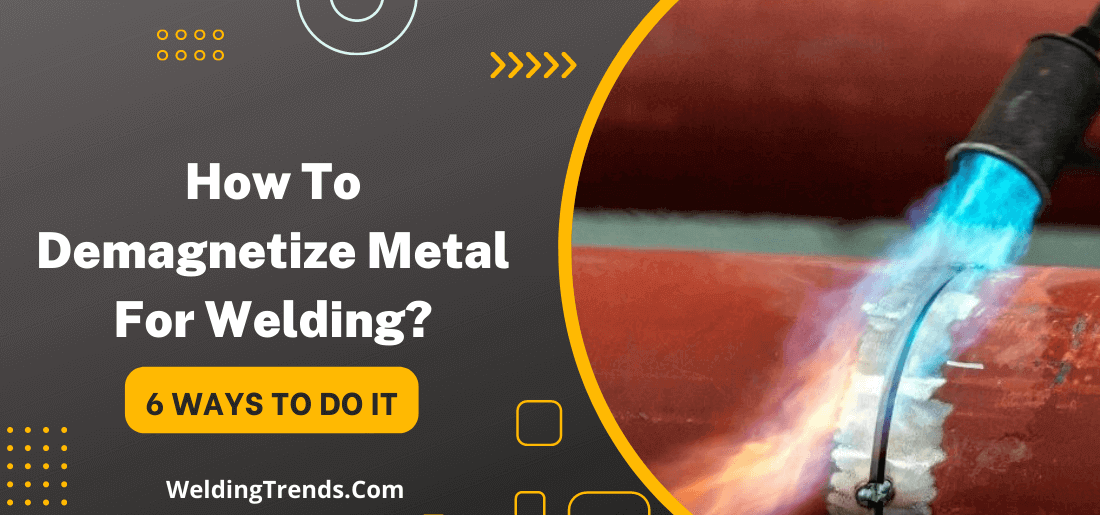Demagnetizing metal is an important process for welding. So, it is essential to know how to demagnetize metal for welding.
In this blog, post we will discuss how to demagnetize metal using a few simple methods. We will also discuss what are the benefits of doing so and what is the risk associated with it. Stay tuned!
What is demagnetization and why do we need to do it for welding?
Demagnetization is the process of reducing or eliminating the magnetic properties of a material. This is often done for the following reasons:
1- Safety reasons
Magnets can be dangerous if left in an uncontrolled environment. For welding, demagnetization is essential because it helps to prevent the formation of arc blow, which can cause welds to be less strong and more likely to fail.
2- To improve weld quality
Arc blow can cause the formation of hot spots and welding defects. By demagnetizing the workpieces before welding, we can help to prevent these issues and improve weld quality.
3- To make it easier to remove welds
If you need to remove a weld, it is often easier to do so if the workpiece is demagnetized first. This is because the magnetic fields can make breaking the bond between the weld and the metal difficult.
4- To prevent corrosion
Corrosion can occur when there is a build-up of static electricity on the surface of a metal. This static electricity can cause decay and demagnetization can help to prevent it.
5- To improve the performance of electrical equipment
Demagnetization can improve the performance of electrical equipment by reducing the possibility of interference from external magnetic fields.
6- To recycle scrap metal
Scrap metal can be recycled more easily if it is demagnetized first. This is because the magnetic fields can make breaking the bond between the scrap and the metal difficult.
7- To protect sensitive equipment
Sensitive equipment can be damaged by strong magnetic fields. By demagnetizing materials, before they are used, we can help to protect this equipment.
How to demagnetize metal/steel?
Here are 6 different ways to demagnetize metal for welding.
1- Heat it
One way to demagnetize metal is by heating it. This can be done by placing it in a fire or using a blow torch. Applying heat to metal will cause it to expand slightly and release any magnetic properties it may have.
2- Use a demagnetizing coil
Another way to demagnetize metal is by using a demagnetizing coil. This is a device that creates an alternating magnetic field, which can cancel out the magnetic properties of metal.
This method is used in industry to quickly demagnetize metal objects.
3- Strike it
Another way to demagnetize metal is to strike it repeatedly with a hammer. This will break up the magnetic fields and make the metal less likely to be attracted to other objects.
4- Demagnetize it with electricity
You can also demagnetize metal by passing an electric current through it. This will cause the magnetic fields to cancel each other out and make the metal less magnetic.
5- By applying mechanical stress
You can also demagnetize metal by putting it under mechanical stress. This can be done by bending or stretching the metal. The stress will cause the magnetic fields to realign and make the metal less magnetic.
6- Use a degaussing coil
Another way to demagnetize metal is by using a degaussing coil. This is a device that creates a strong magnetic field, which can cancel out the magnetic properties of metal.
Different types of degaussers and how to choose the right one for your needs?
When it comes to demagnetization, there are two main types of degaussers:
1- Permanent magnet degaussers:
Permanent magnet degaussers use a strong magnetic field to reduce the magnetic properties of a material. This type of degausser is often used for safety reasons, as it can help to prevent the formation of arc blow.
2- Electromagnetic degaussers:
Electromagnetic degaussers use an electric current to generate a magnetic field, which is then used to reduce the magnetic properties of a material. This type of degausser is often used for welding, as it can help to prevent the formation of weld defects.
When choosing a degausser, it is vital to consider the following factors:
- Type of material you demagnetize: Different materials will require different types of degaussers. For example, permanent magnet degaussers are often used for ferrous materials, while electromagnetic degaussers are often used for non-ferrous materials.
- Size of the material: The size of the material you need to demagnetize will determine the type of degausser you need. For example, large materials will require a larger degausser, while smaller materials will require a smaller degausser.
- Strength of the magnetic field: The strength of the magnetic field you need will determine the type of degausser you need. For example, a stronger magnetic field will require a permanent magnet degausser, while a weaker magnetic field will require an electromagnetic degausser.
- Power source: Different degaussers will require different power sources. For example, some degaussers will require an AC power source, while others will require a DC power source.
- Frequency you need: The frequency you need will determine the type of degausser you need. For example, some degaussers will operate at a single frequency, while others will operate at multiple frequencies.
- Price you are willing to pay: Different degaussers will vary in price, so it is important to consider your budget when choosing a degausser.
- Warranty: Different degaussers will come with different warranties, so it is important to consider the warranty when choosing a degausser.
How can you demagnetize metal using a few simple steps?
If you have a piece of metal that has become magnetized and you want to demagnetize it, there are a few simple steps you can follow.
- First, you need to find a way to physically contact the metal with an electric current. This can be done by using a battery and some wire.
- Once you have the metal in contact with the electric current, you need to move the metal around in a circular motion.
- This will cause the magnetic fields to cancel each other out and demagnetize the metal.
- You can also use a machine that is specifically designed to demagnetize metal.
These machines work by using an electric current to cancel out the magnetic fields in the metal. Follow the instructions that come with the machine properly and safely use it.
What are benefits of demagnetizing metal before welding?
Some benefits of demagnetizing metal before welding include:
1. Reducing the risk of Weld Spatter
When metal is welded, small droplets of molten metal are ejected from the welding arc. If these droplets or spatter land on nearby surfaces, they can cause damage.
Demagnetizing the metal before welding helps to reduce the amount of spatter that is produced.
2. Improving Weld Quality
When metal is welded, the heat from the welding arc can cause the metal to warp. This can lead to uneven welds and imperfections in the finished product.
Demagnetizing the metal before welding helps to reduce warping and improve the overall quality of the weld.
3. Reducing the risk of Porosity
Porosity is a common welding defect that occurs when gas bubbles become trapped in the weld. This can happen if the metal is not properly prepared before welding. Demagnetizing the metal helps to remove any surface contamination that could cause porosity.
4. Increasing productivity
Demagnetizing the metal before welding helps to speed up the welding process. This is because there is no need to clean the metal before welding. This can save time and increase productivity by reducing rework and scrap rates.
Are there any risks associated with demagnetizing metal before welding?
Yes, there are a few risks associated with demagnetizing metal before welding.
- First, if the metal is not completely demagnetized, it can cause problems with the weld.
- Second, if the metal is not properly protected from re-magnetization, it can cause problems with the quality of the weld.
- If the base metal is not properly degaussed, the weld may be excessively porous or have poor penetration. Incomplete fusion at the root of the weld can also occur.
- Demagnetizing can also make the metal more susceptible to cracking.
- Demagnetizing metal before welding can also increase the risk of fire and explosion.
- Additionally, it can also cause the weld to be weaker and less reliable.
- Finally, if the metal is not properly cooled after welding, it can cause problems with the strength of the weld.
How often should you demagnetize metal before welding and how can you tell if it’s been properly done?
There is no definitive answer as to how often you should demagnetize metal before welding. However, a good rule of thumb is to do it whenever you notice that the metal has become magnetized.
You should demagnetize metal before welding to ensure that the weld will be strong and free of defects. If you’re not sure whether or not the metal has been properly demagnetized, you can test it with different methods including:
- With a piece of paper: If the paper sticks to the metal, then it’s still magnetic. However, if the paper slides off, then the metal is no longer magnetized.
- With a magnet: If the metal is not attracted to the magnet, then it has been properly demagnetized.
- With a compass: If the needle of the compass moves when you bring it near the metal, then the metal is magnetic. However, if the needle does not move, then the metal is not magnetized.
- With a voltmeter: If the meter reading changes when you bring the metal close to it, then the metal is still magnetic. However, if the reading stays the same, then the metal has been properly demagnetized.
Tips for Safely and Effectively Demagnetizing Metal
Demagnetizing metal is a crucial process in various applications, ensuring materials behave as expected in their environments. Here are some tips for safely and effectively demagnetizing metal:
- Use a Demagnetizing Coil: Encase the metal in a coil through which alternating current (AC) is passed. Slowly withdraw the metal from the coil, which helps scatter the magnetic domains.
- Heating: Heat the metal beyond its Curie temperature, the point at which its magnetic properties are lost. Ensure this is done in a controlled environment to avoid altering the metal’s properties.
- Hammering: Physical impact can disturb the alignment of magnetic domains. Gently tap the metal along different axes, but be cautious not to damage or deform it.
- AC Demagnetizing Field: For industrial applications, pass the item through an alternating current demagnetizing field, slowly increasing and then decreasing the field strength to neutralize the magnetic properties.
Always prioritize safety by wearing protective gear and conducting processes in environments free from hazards. Additionally, follow manufacturer instructions and seek expert advice when demagnetizing valuable or sensitive materials.
FAQs – demagnetize metal for welding
How do you demagnetize pipes before welding?
There are a few ways to do this, but the most common is to use an electromagnet. This will create a magnetic field that will oppose the magnetic field of the pipes, causing them to become demagnetized.
Pipes can be demagnetized using a process called degaussing. Degaussing involves running an electric current through the pipe to remove any residual magnetism.
Finally, you can use a process called “eddy current induction” to create a magnetic field that will cause the pipes to become demagnetized.
How do you demagnetize 304 stainless steel?
304 stainless steel can be demagnetized by heating it to a temperature of around 800 degrees Celsius. This will cause the magnetic properties of the metal to change and it will no longer be attracted to magnets.
If you need to remove all traces of magnetism from 304 stainless steel, you can do so by exposing it to a strong magnetic field. This will cause the metal to lose its magnetic properties completely.
How do you remove magnetism from a pipe?
Pipes are often made of ferrous metals, which means they are susceptible to magnetism. If you need to remove magnetism from a pipe, there are a few different methods you can try.
- One way to remove magnetism from a pipe is to heat it. The heat will cause the atoms in the metal to vibrate, which will disrupt the magnetic field.
- Another way to remove magnetism is to strike the pipe with a hammer. The impact will also disrupt the magnetic field.
- If you need to remove magnetism from a large pipe, you can try using an electromagnet. The electromagnet will create a magnetic field that will cancel out the pipe’s magnetic field.
Conclusion
To weld properly, the metal must be demagnetized first. This can be done with a simple piece of equipment called a demagnetizer. Using a demagnetizer is quick and easy and it will allow you to get the best results from your welding projects.
Always remember to practice safety first when welding and handle magnetized materials with care. If you follow the steps we’ve outlined, demagnetizing metal for welding should be a breeze. Thanks for reading!




